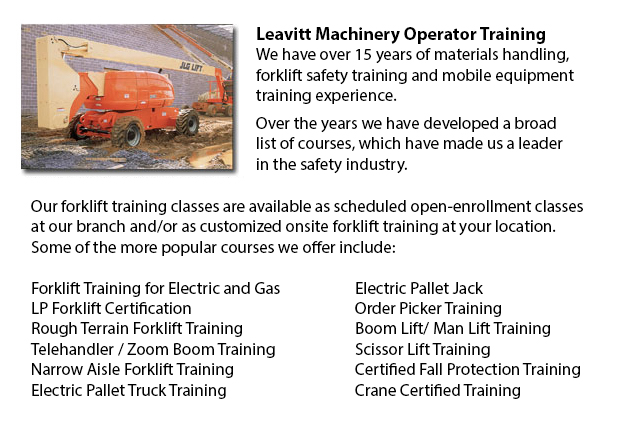
Aerial Lift Safety Training Burlington - There are roughly 26 to 30 construction deaths within North America due to the utilization of aerial lifts. Nearly all of the individuals killed are craftsmen such as electrical workers, laborers, painters, ironworkers or carpenters. Nearly all deaths are caused by tip-overs, electrocutions and falls. The greatest danger is from boom-supported lifts, like for example bucket trucks and cherry pickers. Most fatalities are related to this type of lift, with the rest involving scissor lifts. Other dangers comprise being thrown out of a bucket, being struck by falling objects, and being caught between the lift bucket or guardrail and a thing, like for instance a steel beam or joist.
To safely operate an aerial lift, perform an inspection on the following things before making use of the device: emergency and operating controls, safety devices (e.g., guardrails and outriggers), personal fall protection gear, and wheels and tires. Check for possible leaks in the air, fuel-system, hydraulic fluid. Check the device for loose or missing parts.
The places where worker would utilize the aerial device must be inspected carefully for possible hazards, like for instance holes, bumps, drop-offs and debris. Overhead powerlines have to be monitored and avoided. It is suggested that aerial lift devices be used on surfaces which are stable and level. Don't work on steep slopes that exceed slope restrictions that the manufacturer specified. Even on a level slope, brakes, wheel chocks and outriggers should be set.
Businesses must provide their aerial lift operators with the right instruction manuals. Mechanics and operators must be trained by a licensed person experienced with the relevant aerial lift model.
Aerial Lift Safety Guidelines:
o Before operating, close doors and lift platform chains.
o Do not lean over or climb on guardrails. Stand on the floor of the bucket or platform.
o Stay within manufacturer's load-capacity restrictions.
o When working near traffic, make use of correct work-zone warnings, like for instance signs and cones.
If proper procedures are followed, electrocutions are avoidable. Stay at least ten feet away from whatever power lines and qualified electricians must de-energize and/or insulate power lines. Workers must use personal protective tools and equipment, like for instance insulated bucket. Then again, a bucket that is insulated does not protect from electrocution if, for example, the worker touches another wire providing a path to the ground.
Falls are preventable if the person working remains secure within guardrails or within the bucket by utilizing a full-body harness or a positioning device. If there is an anchorage inside the bucket, a positioning belt with a short lanyard is adequate.
By following the manufacturer's directions, tip-overs could be avoided. Never drive the lift platform when it is elevated, unless the manufacturer specifies otherwise. Adhere to the device's vertical and horizontal reach restrictions, and never go beyond the specified load-capacity.
-
Order Picker Training Burlington
Order Picker Training Burlington - Order picker's enables warehouse employees to lift pallets using forks. Also called a stock picker, this particular electrically-powered equipment is similar to a forklift except that an order picker is likewise uti... More -
Crane Certification Burlington
Crane Certification Burlington - The Crane Certification training program includes content recommended by industry regarding the efficient and safe operation of cranes. Trainees would learn the following: how to identify cranes and their component pa... More -
Overhead Crane Training Burlington
Overhead Crane Training Burlington - The overhead crane is a piece of equipment which can lift and move huge, heavy objects which can't be handled by hands. Typically, overhead cranes are fixed in place. These equipment are capable of moving huge vol... More -
Aerial Lift / Boom Lift / Man Lift / Scissor Lift Training in Burlington
Lift tables or scissor lifts could elevate both people and goods vertically. They are normally used in construction, commercial and industrial environments. Commonly, the use of a scissor lift is to lift and lower supplies from one floor of a job loc... More -
Telehandler Operator Training Burlington
Telehandler Operator Training Burlington - Telescopic Handler forklifts or telehandler forklifts are usually found on construction places and their popularity continues to rise. The versatility of telehandler forklifts ensures that they are a valuabl... More -
Forklift Training Classes Burlington
Forklift Training Classes Burlington - Forklift are heavy pieces of industrial machines that are made use of in transporting and the handling of merchandise and materials. They are often known as Lift trucks and are found in all sorts of businesses.... More -
Boom Lift Training Burlington
Boom Lift Training Burlington - Aerial platforms or also known as elevated work platforms are devices that allow workers to perform tasks and duties at elevated heights that would not be otherwise accessible. There are a variety of aerial lifts avail... More -
Bucket Truck Training Burlington
Bucket Truck Training Burlington - The Vehicle-Mounted Aerial Work Platform or also called bucket truck training program is intended to decrease the risk of incident and personal injury while working in close proximity or with bucket trucks by effici... More

Forklift Training Burlington
TOLL FREE: 1-888-254-6157
Burlington, Ontario
forklifttrainingburlington.com
Email Us
About Us


